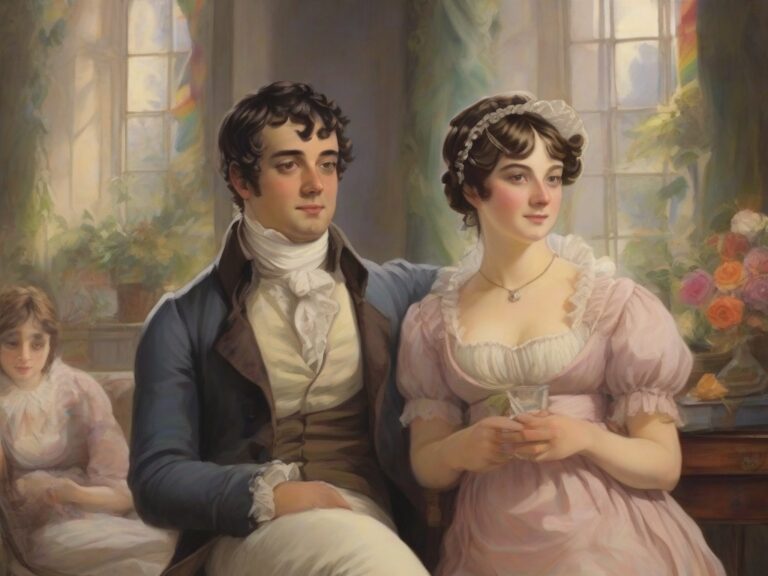Have you ever wondered what life was like in the early 19th century, particularly for young women seeking love and independence? If so, you’re in for a delightful journey through the pages of Jane Austen’s timeless classic, Pride and Prejudice.
This remarkable novel has enthralled readers for over two centuries, captivating them with its unforgettable characters, vivid portrayal of a bygone era, and the timeless themes of love, societal norms, and personal growth. In this comprehensive article, we delve into the intricate world Austen created, exploring the captivating storylines, exploring the social and cultural backdrop against which it unfolds, and uncovering the profound messages that still resonate with readers today. Join us as we embark on a literary adventure, decoding the nuances of Pride and Prejudice notes and unveiling why it continues to be regarded as one of the greatest novels of all time.
Pride and Prejuice book by Jane Austen: Full Book Summary
Once upon a time in a quaint English village, there lived a lively and imaginative young girl named Elizabeth Bennet. She was the second eldest of five sisters and had a keen sense of adventure. Elizabeth’s family, the Bennets, were of modest means but held their heads high with pride. Their father, Mr. Bennet, was a kind and witty gentleman, who loved to read and spend time in his library.
Elizabeth and her older sister, Jane, were the closest of friends while their younger sisters, Mary, Kitty, and Lydia, were more prone to mischief and frivolity. Mrs. Bennet, their mother, was forever determined to find suitable matches for her daughters, as marriage was the ultimate goal for young ladies in those times. The prospect of finding a rich and eligible bachelor excited Mrs. Bennet greatly.
One fateful day, a wealthy bachelor named Mr. Bingley arrived in the village. He rented a grand estate called Netherfield, and his arrival created quite a stir among the townspeople. The Bennet sisters’ ears pricked up at the sound of the news, for they had heard rumors of Mr. Bingley’s unmarried status and great fortune.
Summary of the book Pride and Prejudice
Mr. Bingley attended a local ball, and there he was immediately smitten by Jane’s beauty and gentle demeanor. The two danced together and spent the entire evening in each other’s company. Jane was thrilled by Mr. Bingley’s attentions and secretly hoped for a deeper connection between them. Elizabeth watched her sister’s happiness with a delighted heart, believing that true love was within reach for them.
Meanwhile, Mr. Bingley’s wealthy and proud friend, Mr. Fitzwilliam Darcy, had also come to town. Mr. Darcy’s arrogant and aloof behavior immediately irked Elizabeth, and she formed a quick judgment against him. She considered him to be rude and superior, doubting that anything he said or did could redeem him in her eyes.
Despite Elizabeth’s initial dislike of Mr. Darcy, he became infatuated with her vivacious spirit and intelligence. However, due to his pride and prejudice, he held back from expressing his true feelings and instead indulged in a battle of words and wits with Elizabeth whenever they met. Their verbal sparring was a constant source of excitement for their friends and family.
Elizabeth’s younger sisters, Lydia and Kitty, were thrilled by the arrival of the regiment in town. The soldiers brought with them a lively atmosphere, full of dances and parties. The regiment’s officers, including a charming charmer named George Wickham, quickly became the center of attention. Wickham had a personal vendetta against Mr. Darcy and revealed to Elizabeth that he had been ill-treated and wronged by Mr. Darcy in the past. Elizabeth, considering Wickham’s words as fact, fueled her dislike for Mr. Darcy even further.
Pride and Prejudice Summery
One day, Mr. Bingley abruptly left Netherfield, leaving Jane heartbroken and bewildered. Elizabeth’s heart ached for her sister’s pain, and she couldn’t help but resent Mr. Bingley’s hasty departure. She blamed it solely on Mr. Darcy’s interference, convinced that his pride had driven a wedge between Jane and her beloved.
As time went on, Mr. Darcy found his feelings for Elizabeth growing stronger by the day. He realized that he cared deeply for her and wished to make amends for his past actions. Gathering his courage, he penned a heartfelt letter to Elizabeth, laying bare his emotions and revealing the true nature of the events involving Wickham. Elizabeth’s prejudiced view of Mr. Darcy began to crumble as she read his letter, and for the first time, she saw him in a different light.
In the midst of these whirlwind emotions, Lydia’s carefree naivety led her into a scandalous elopement with Mr. Wickham. The entire Bennet family was mortified by the disgrace brought upon them. Elizabeth’s heart was heavy with concern for her sister’s future. It was at this critical moment that Mr. Darcy selflessly stepped in, organizing a search and using his influence to locate and rescue Lydia.
News of Mr. Darcy’s generosity and self-sacrifice reached Elizabeth, and she was forced to reevaluate her opinion of him. She realized that her pride and prejudice had blinded her to the true character beneath his haughty exterior. As gratitude and admiration swelled within her, Elizabeth finally admitted her own growing love for Mr. Darcy.
Eventually, Mr. Bingley returned to Netherfield, still harboring deep affections for Jane. He apologized for his sudden absence, explaining that it had been influenced by the misguided advice of Mr. Darcy. Jane, ever forgiving and understanding, accepted Mr. Bingley’s apology and allowed her heart to open once again to love.
Pride and Prejuice: Key Themes
“Pride and Prejudice” is a classic novel written by Jane Austen, first published in 1813. Set in 19th-century England, the story follows the lives and romantic pursuits of the Bennett family, particularly the witty and independent Elizabeth Bennett and the proud and wealthy Mr. Darcy. This novel explores various social themes and critiques the rigid societal norms and expectations, particularly in regards to love and marriage. Here are three key themes of “Pride and Prejudice”:
1. Social Class and Marriage:
One of the central themes in the book is the importance of social class and its influence on marriage. The society depicted in “Pride and Prejudice” has strict societal hierarchies where individuals are judged based on their background and wealth. Marriage is seen as a means of securing financial stability and social status. Throughout the novel, characters like Mrs. Bennett are desperate to marry off their daughters to wealthy suitors, whereas characters like Elizabeth prioritize love and compatibility over social standing. Austen questions the notion of marriage as a purely economic transaction and highlights the negative consequences of marrying solely for societal advancement.
2. Prejudice and First Impressions:
The title “Pride and Prejudice” directly refers to the key themes explored in the novel. The story shows how prejudiced judgments and hasty first impressions can lead to misunderstandings and miscommunication. Initially, the protagonist Elizabeth harbors prejudice against Mr. Darcy, influenced by her pride and his aloof demeanor. Similarly, Mr. Darcy forms a negative opinion of the Bennett family due to their lower social status. As the plot unfolds, Austen challenges these prejudices by revealing the complexity and depth of the characters. Elizabeth’s prejudice is shattered when she discovers Mr. Darcy’s true character, and his pride is humbled by her intelligence and wit.
3. Women’s Agency and Independence:
“Pride and Prejudice” reflects Austen’s exploration of the limited opportunities available to women during the time period. The novel depicts the societal expectations for women to prioritize finding a husband and securing financial stability. However, Austen’s female characters, particularly Elizabeth, challenge these expectations and assert their agency and independence. Elizabeth refuses to conform to the societal pressures of marrying for security and instead seeks a partner who respects and understands her. She rejects two marriage proposals, demonstrating her determination to make her own choices. Austen’s portrayal of strong-willed, intelligent women suggests that women deserve to have a voice in their own lives and should not be confined by societal expectations.
Overall, “Pride and Prejudice” delves into the themes of social class, prejudice, and women’s agency, using wit and irony to provide social commentary on the regency era society and its limitations.
Pride and Prejuice: Characters
1. Elizabeth Bennet:
As the intelligent and witty protagonist, Elizabeth captivates readers with her sharp tongue and independent spirit. With her lustrous chestnut hair and sparkling hazel eyes, she is known for her striking beauty. Elizabeth’s love for reading and engaging in intellectual discussions makes her stand out among her peers. A master of wit, she often challenges societal norms and refuses to conform to traditional expectations, leading to several comical encounters throughout the story.
2. Mr. Fitzwilliam Darcy:
Tall and handsome, Mr. Darcy exudes an air of quiet sophistication. His dark, brooding eyes and perfectly tousled jet-black hair add to his striking appearance. Though often perceived as arrogant and aloof, he possesses an immense sense of responsibility and loyalty. Mr. Darcy’s social awkwardness and tendency to speak his mind at the most inappropriate moments create hilariously uncomfortable situations that add a touch of comedy to the narrative.
3. Jane Bennet:
The epitome of grace and beauty, Jane possesses an enchanting smile and radiant golden curls. With her gentle and kind-hearted nature, she is adored by all who meet her. Jane’s unwavering optimism and belief in the goodness of others shines throughout the story as she navigates the complexities of love, often leading to amusing misunderstandings.
4. Charles Bingley:
Bingley’s charming demeanor and infectious laughter make him a favorite among the characters. With his rosy cheeks and perpetual smile, he is the true embodiment of joviality. Bingley’s clumsiness and tendency to blush at the most inconvenient times provide humorous moments that lighten the tension in the story.
5. Mrs. Bennet:
Mrs. Bennet, a bundle of nerves and exaggerated emotions, is a force to be reckoned with. Her wild, untamed curls and perpetually flushed face mirror her boisterous personality. As a mother eager to secure advantageous marriages for her daughters, Mrs. Bennet’s relentless determination and over-the-top antics deliver comic relief at every turn.
6. Mr. Bennet:
The intellectual and reserved father of the Bennet family, Mr. Bennet is known for his dry wit and sarcasm. With his unruly salt-and-pepper hair and spectacles perched atop his nose, he adds an element of sophistication to the story. Mr. Bennet’s tendency to tease and provoke his wife with subtle remarks generates comic interactions, leaving readers in stitches.
7. Lydia Bennet:
Often seen as the wild child of the Bennet family, Lydia’s mischievous nature is evident in her playful, mischievous eyes and boisterous laughter. Her vibrant red curls and impulsive behavior make her a source of both amusement and exasperation. Lydia’s tendency to get into outrageous predicaments provides comedic escapades throughout the novel.
8. Charlotte Lucas:
Charlotte possesses a calm and composed demeanor, beautifully reflected in her serene blue eyes and elegant braided hair. As Elizabeth’s closest confidante, she often finds herself caught between her friend’s wit and society’s expectations. With her dry humor and unwavering practicality, Charlotte offers a grounded perspective that adds a touch of comedy to the story.
9. Mr. Collins:
Mr. Collins’s distinctive feature is his impeccably groomed handlebar mustache, which he proudly sports along with his overly polished appearance. His exaggerated bowing and pompous mannerisms offer endless amusement as he unsuccessfully attempts to impress the Bennet family. Mr. Collins’s misguided attempts at flattery and declaration of love result in some of the most comical moments in the story.
Pride and Prejuice: Symbols
The three most significant symbols in Jane Austen’s Pride and Prejudice are as follows:
1. Pemberley:
Pemberley, the grand estate owned by Mr. Darcy, serves as a powerful symbol in the novel. It represents not only wealth and luxury but also becoming the embodiment of the ideal home and family life. The description of Pemberley showcases its beautiful gardens, elegant architecture, and impeccable maintenance. Pemberley symbolizes Mr. Darcy’s transformation from an arrogant and distant figure, associated with his large fortune, to a more compassionate and worthy character. Elizabeth’s visit to Pemberley influences her perception of Darcy, causing her to reassess her initial prejudice against him.
2. Letters:
Throughout the novel, letters serve as a symbol of communication and revelation of true feelings. The exchange of letters plays a crucial role in the development of the plot and the relationships between characters. The letters allow for private and honest expressions of thoughts and emotions that are sometimes concealed or misunderstood during face-to-face interactions. For instance, Mr. Darcy’s letter to Elizabeth serves as a turning point in the story, as it discloses the truth behind his actions and reveals his true character. This symbol highlights the significance of open and honest communication in fostering understanding and overcoming misunderstandings.
3. Meryton Assembly Hall:
The Meryton Assembly Hall represents the social gatherings and conventions of the time. It serves as a symbol of social class, hierarchy, and societal expectations. The events taking place in this setting convey the importance of marriage in the Regency era society, where it was often seen as a means of financial security and social advancement. The Assembly Hall also serves as a microcosm of the novel’s themes of pride and prejudice, as characters passionately discuss and judge each other based on appearances, wealth, and social status. This symbol illustrates the constraints and limitations imposed by societal norms and expectations on individuals, particularly women, and the challenges they face in navigating these societal expectations.
These symbols in Pride and Prejudice contribute to the multi-layered exploration of themes such as love, social class, pride, and prejudice that form the essence of the novel.
Pride and Prejuice: Culture Impact
Pride and Prejuice, a timeless novel written by Jane Austen, has had a monumental cultural impact since its publication in 1813. This enchanting love story set in the backdrop of 19th-century England has transcended time and captivated audiences through its wit, humor, and remarkable achievements.
Historically, Pride and Prejuice stands as an influential work that sheds light onto the social norms and customs of the Regency era. Austen intricately painted a vivid picture of the hierarchical society, where class divisions, etiquette, and arranged marriages were central. By satirizing these societal conventions, Austen skillfully critiqued the limitations placed upon women, sparking introspection and a desire for equality. This revolutionary perspective helped pave the way for social change and challenged the established norms of the time.
Funny and filled with brilliant comedic moments, Pride and Prejuice became renowned for its wit and sharp humor. Austen expertly crafted the characters and dialogue to deliver clever insights into human behavior and social interactions. From the entertaining banter between Elizabeth Bennet and Mr. Darcy, to the humorous portrayal of the pompous Mr. Collins, the novel seamlessly weaves comedy into its intricate plot. This humor not only adds levity to the story but also offers a nuanced commentary on the follies of pride and prejudice that continues to resonate with readers today.
One of the audiobooks remarkable achievements is its ability to explore complex themes within a seemingly simple love story. Beneath the surface, Pride and Prejuice delves into themes of love, marriage, reputation, and societal expectations. Austen’s portrayal of the intricate dance between love and societal constraints struck a chord with readers, who found themselves reflecting on their own relationships and the influence of social pressures on their choices. The undeniable relatability of these themes has allowed Pride and Prejuice to endure for over two centuries and remain a beloved classic.
Moreover, Pride and Prejuice has spawned countless adaptations, retellings, and homage throughout the years. From film adaptations to stage productions and modern retellings, the story has garnered a dedicated and passionate fan base. These adaptations have not only brought the story to new generations but also highlighted its timeless themes in a variety of settings, further solidifying the book’s cultural impact.
In conclusion, Pride and Prejuice has left an indelible mark on culture, blending historical insights, clever humor, and enduring achievements. This novel has not only entertained readers for generations but has also prompted reflection on societal norms, challenged gender roles, and offered timeless insights into the complexities of human relationships. Jane Austen’s masterpiece continues to inspire and enchant, ensuring its place as a cultural touchstone for years to come.
FAQs
1. Who is the author of Pride and Prejudice?
The author of Pride and Prejudice is Jane Austen.
2.When was Pride and Prejudice first published?
Pride and Prejudice was first published on January 28, 1813.
3. What is the plot of Pride and Prejudice?
Pride and Prejudice follows the story of Elizabeth Bennet, a young woman who faces societal pressures and expectations while navigating love, marriage, and class distinctions in Regency England. The novel explores themes of prejudice, social status, and the search for true love.
4. Who are the main characters in Pride and Prejudice?
The main characters in Pride and Prejudice include Elizabeth Bennet, Fitzwilliam Darcy, Jane Bennet, Charles Bingley, Mr. Bennet, Mrs. Bennet, Mr. Collins, and Lady Catherine de Bourgh, among others.
5. What is the significance of the title “Pride and Prejudice”?
The title “Pride and Prejudice” represents two central themes explored in the novel. Pride refers to the characters’ personal pride, sometimes leading to arrogance or prejudice. Prejudice, on the other hand, highlights the tendency to judge others based on initial impressions and assumptions. The title alludes to the personal growth and transformation of the characters as they overcome these traits throughout the story.
6. What is the main message of Pride and Prejudice?
The main point of Pride and Prejudice is that love can overcome the obstacles of pride and prejudice, and that people should not judge others based on their first impressions. The novel shows how Elizabeth and Darcy, who initially dislike each other, gradually overcome their misunderstandings and prejudices and fall in love. The novel also criticizes the social norms and expectations of the 19th-century England, especially the role of women and the importance of marriage and money.
7. What is the significance of the novel’s opening line?
The novel’s opening line summarizes the story that follows by focusing the reader’s attention on the subject of marriage and the two main characters to come: “the single man in possession of a good fortune”—Mr. Darcy—and his wife-to-be—Elizabeth Bennet. The opening line also introduces the irony and satire that Austen uses throughout the novel, as she mocks the assumption that a wealthy man must be in want of a wife, and that a woman’s main goal is to marry well.
8. Why does Lizzy reject Darcy’s first proposal to her?
Lizzy rejects Darcy’s first proposal because while he admits to loving her, he also says many insulting things about her family and social position. Darcy makes clear “his sense of her inferiority, of its being a degradation, of the family obstacle, which judgment had always opposed to inclination.” He also seems confident that she will consider it an honor to marry him. These attitudes are offensive to Lizzy, because she does not think Darcy is inherently better than her. She also accuses him of ruining the happiness of her sister Jane and of treating Wickham unjustly.
9. How does Darcy change throughout the novel?
Darcy changes throughout the novel by becoming more humble, generous, and respectful of others. He realizes that his pride and arrogance have blinded him to his own faults and to the true worth of Elizabeth. He tries to amend his mistakes by helping Lydia and Wickham, by reconciling Jane and Bingley, and by being more polite and friendly to Elizabeth’s relatives. Also confesses his love for Elizabeth in a more sincere and respectful manner, and asks for her forgiveness and acceptance.
10. How does the relationship between Elizabeth and Jane differ from the relationship between Lydia and Kitty?
Elizabeth and Jane have a close and affectionate relationship, based on mutual respect, trust, and understanding. They share their thoughts and feelings, and support each other through their joys and sorrows. They are also the most sensible and intelligent of the Bennet sisters, and they do not let their emotions cloud their judgment. Lydia and Kitty, on the other hand, have a superficial and frivolous relationship, based on their common interest in gossip, fashion, and flirting. They are the most foolish and irresponsible of the Bennet sisters, and they do not care about the consequences of their actions. They also do not listen to the advice of their elder sisters, and often cause trouble and embarrassment for their family.
11. Which pride and prejudice movie is closest to the book?
There are several adaptations of Jane Austen’s Pride and Prejudice novel, each with its own unique interpretation. According to , the 2005 adaptation directed by Joe Wright is the closest to the book. The adaptation focused on the romance between Elizabeth and Mr. Darcy, cutting down on subplots and condensing the novel into a 127-minute movie. Keira Knightley’s portrayal of Elizabeth was significantly feistier and more impassioned than in the original novel. The Bennet family in the film was portrayed as much poorer than in the novel, but also more sympathetic and close-knit. The adaptation also cut minor characters and condensed subplots, making it a stronger movie.
12. How long is pride and prejudice audiobook?
The length of the audiobook version of Pride and Prejudice by Jane Austen varies depending on the narrator and the edition. According to , the audiobook narrated by Juliet Stevenson is 14 hours and 2 minutes long. Another version narrated by Karen Savage is 11 hours and 1 minute long . The audiobook narrated by Rosamund Pike is 11 hours and 35 minutes long .










